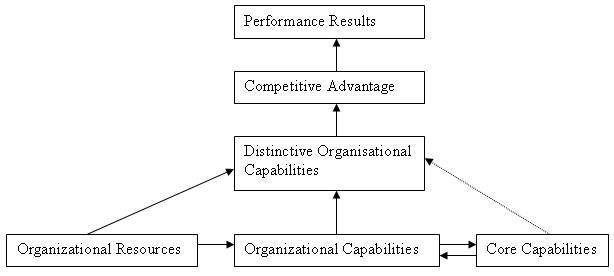Today’s competitive landscape makes it more difficult for companies to expect that they can sustain a level of strategic competitiveness strictly by managing the costs of labour, capital, and raw materials (because, in a global environment, all companies potentially can do this).
Internal analysis adopts the position that the Resource Based model of competitive advantage may be the key to a company’s ability to achieve strategic competitiveness, by treating each company as a bundle or set of heterogeneous resources and capabilities. In other words, resources and capabilities are not equally distributed among companies as is assumed by the 1/0 model of strategic competitiveness.

By using or exploiting their core competencies, companies are in a position to develop and perform value creating strategies better than their competitors or to create and perform value creating strategies those competitors either are unable or unwilling to imitate.
As stated in figure above, A company’s tangible and intangible resources (for example, its facilities and corporate culture, respectively) represent sources of capabilities. These capabilities (teams or bundles of resources) represent sources of core competencies, which when exploited and nurtured (and valuable, imperfectly imitable, rare, and non-substitutable), are potential sources of competitive advantage, If a company is able to use its core competencies to achieve a competitive advantage, it will achieve strategic competitiveness and earn above average returns so long as competitors are unable or unwilling to imitate them successfully.
The importance of a company’s internal characteristics, represented by its resources and capabilities, highlights a shift in the priorities and prescriptions of strategic management research. The field has evolved or developed from a position that understanding industry characteristics and then positioning the company to take advantage of these characteristics relative to competitors is of primary importance. It also recognizes that if his company’s resources and capabilities (which represent sources of core competencies) that should serve as the foundation for company strategy
This shift recognizes that industry attractiveness is not dependent only on industry characteristics. Industry attractiveness is ultimately determined by both industry characteristics (which can be translated into opportunities and threats) or what a company might do and its internal strengths (its resources, capabilities, and core competencies) which determine what a company is capable of doing to take advantage of (or exploit) external opportunities.
 Brighten Your Career Path This Diwali - Invest in Yourself!
Brighten Your Career Path This Diwali - Invest in Yourself! 
